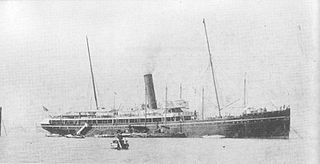
Saikyō Maru (西京丸) was a steamship that was built in 1888 in Scotland for Japanese merchant service. She was requisitioned for service in the First Sino-Japanese War of 1894–95 and the Russo-Japanese War of 1904–05. She was scrapped in 1927.
SS Cambridge was a refrigerated steam cargo liner that was built in Germany for the Hamburg America Line. She was launched in 1916 as Vogtland, but after the 1919 Treaty of Versailles the United Kingdom took her as war reparations and sold her to the Federal Steam Navigation Company, who renamed her Cambridge. She operated between Britain and Australasia until 1940, when a German mine sank her off the coast of Australia.

SS Cleveland was a German transatlantic ocean liner that was launched in 1908 and scrapped in 1933. Cleveland was built for the Hamburg America Line (HAPAG) as a sister ship for Cincinnati.
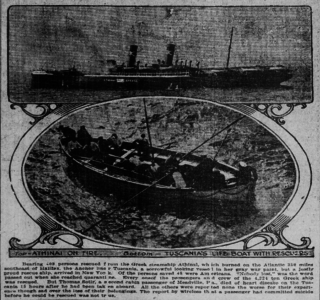
SS Athinai was a Greek passenger steamship that was built in England in 1908 and sank in the North Atlantic in 1915. She was built to be a transatlantic ocean liner, but she served also as a troop ship.
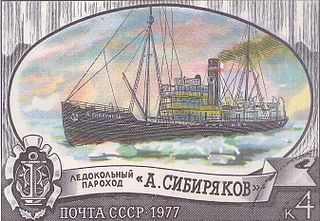
Alexander Sibiryakov was a steamship that was built in Scotland in 1909 as Bellaventure, and was originally a seal hunting ship in Newfoundland. In 1917 the Russian government bought her to be an icebreaker. She served the RSFSR and Soviet Union until 1942, when she was sunk by enemy action. The ship gave notable service in the Russian Arctic during the 1930s.
SS Dundee was a British steamship that was built in Scotland in 1911 and sunk by enemy action in the Celtic Sea in 1917. She was designed as a coastal passenger and cargo liner for the Dundee, Perth & London Shipping Company Ltd, but in 1915 she was converted into an armed boarding steamer for the Royal Navy. She took part in the Action of 16 March 1917, was sunk by a U-boat six months later, and lost members of her crew in both actions.
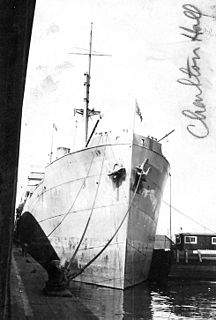
USS Charlton Hall (ID-1359) was a cargo steamship that was built in Scotland in 1907 and served in the merchant fleets of the United Kingdom, United States and Greece. She served in the United States Navy in 1918. She was renamed Atlantis and then Anastasis in 1930. She was scrapped in China in 1934.
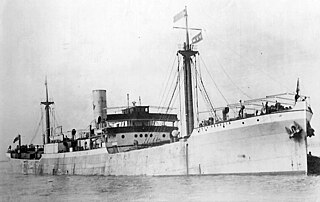
USS Santa Rosalia (ID-1503) was a cargo steamship that was built in Scotland in 1910 and served in the merchant fleets of the United Kingdom, United States and Greece. She served in the United States Navy in 1918–19. She was renamed Stefanos Costomenis in 1929 and sank in the North Atlantic in 1936.

SMS Leopard was a British cargo steamship that was built in 1912 as Yarrowdale, captured in 1916 by the Imperial German Navy, converted into a commerce raider in Germany, and sunk with all hands by the Royal Navy in 1917.

SS Waroonga was a steel-hulled passenger and cargo steamship that was launched in Scotland in 1882, renamed Bansei Maru in 1913 and scrapped in Japan in 1926. Her career included periods in British, Australian and Japanese ownership.

MV Struma was a small ship with a long history that included a number of changes of use and many changes of name. She was built in 1867 as a British marquess's luxury steam yacht and ended up 75 years later as a Greek and Bulgarian diesel ship for carrying livestock. She was launched as Xantha, but subsequently carried the names Sölyst, Sea Maid, Kafireus, Esperos, Makedoniya and finally Struma.
SS Darien was a refrigerated cargo ship of the United Fruit Company. Cammell Laird of Birkenhead, England built her as MV La Marea, completing her in 1924. She had been renamed Darien by 1930 and had been re-engined from diesel to steam by 1931.
SS Hertford was a refrigerated cargo steamship that was launched in Germany in 1917, seized by the United Kingdom in 1920 as World War I reparations, and sunk by a U-boat in 1942 with the loss of four members of her crew.
TSS City of Belfast was a passenger steamship that was built in England in 1893, renamed Nicolaos Togias in 1925, renamed Kephallinia in 1933 and sank in 1941. She was owned and registered in Britain until 1925, when she passed to Greek owners.

SS Frederica was a passenger ferry that was built in Scotland in 1890 for the London and South Western Railway. In 1912 she was sold to Ottoman owners who renamed her Nilufer. In 1914 the Ottoman Navy used her as a minelayer. A mine sank her in November 1914.

SS Lydia was a passenger ferry that was built in Scotland in 1890 for the London and South Western Railway. From 1920 onward she passed through several owners. In 1923 she was renamed Ierax and registered in Greece. She was scrapped in 1933.
Rahmi Kaptan was a ship that was built in 1873 as Honfleur by Aitken & Mansel, Glasgow for the London and South Western Railway. She was sold to Greece in 1911 and renamed Chrysallis then Chrysalis. She was sold to the French Navy in 1917 and served as the patrol vessel Fauvette, later Fauvette I. In 1924, she was sold to Turkey and renamed Ihsanie. She operated for a number of Turkish owners under the names Aidin, Aydin, Cihat, Demirhisar and Rahmi Kaptan, serving until c.2005.
SS Huntingdon was a refrigerated steam cargo liner that was built in Germany in 1920 as Münsterland. The United Kingdom took her as war reparations and sold her to the Federal Steam Navigation Company, who renamed her Huntingdon. She operated between Britain and Australasia until 1941, when an Italian submarine sank her in the Atlantic Ocean.
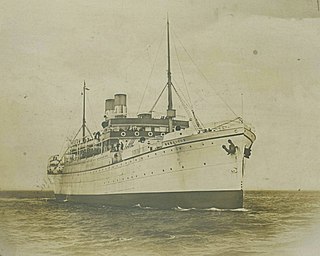
SS Themistocles was a Greek passenger steamship that was built in England in 1907 as Moraitis, renamed Themistocles in 1908, and scrapped in Italy in 1933. She was built to be a transatlantic ocean liner, but she served also as a troop ship.
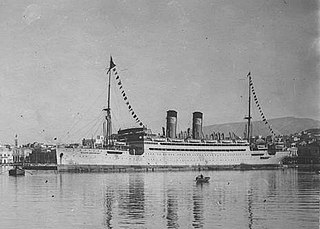
SS Byron was a transatlantic ocean liner that was built in England in 1914 and scrapped in Italy in 1937. She was launched as Vasilefs Constantinos, named after Constantine I of Greece. In 1919 she was renamed Megali Hellas, the Greek name for the Ancient Greek settlements in Sicily and southern Italy. In 1923 she was renamed Byron, in recognition of the role of Lord Byron (1788–1824) in the Greek War of Independence (1821–29).













